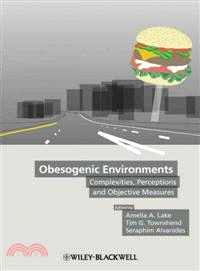Obesogenic Environments - Complexities, Perceptions And Objective Measures
商品資訊
定價
:NT$ 4093 元優惠價
:90 折 3684 元
若需訂購本書,請電洽客服 02-25006600[分機130、131]。
相關商品
商品簡介
作者簡介
名人/編輯推薦
目次
商品簡介
In a world where obesity has now reached epidemic proportions, a thorough understanding of the underlying causes of the problem is essential if society, public health initiatives and government policies are to successfully address the issue. The obesogenic environment describes all the possible influences that our environment presents which encourage overweight and obesity in individuals and populations.
Beginning with an overarching introduction to obesity and its implications for health and wellbeing, the book will move on to consider such crucial areas as eating behaviours and food environments, physical activity and the environment, the urban environment, methods, policy and future research directions.
Brings together expertise from across a range of disciplines
Written by a truly multidisciplinary team of international authors
Presents some of the most innovative thinking in the battle against obesity
This groundbreaking book brings together for the first time the knowledge of experts with backgrounds in nutrition and dietetics, policy, epidemiology, environmental sciences, medical sciences, town planning and urban design, transport, geography and physical activity in order to offer a multidisciplinary approach to public health, suggesting new and exciting ways to shape our environment to better support healthful decisions.
Beginning with an overarching introduction to obesity and its implications for health and wellbeing, the book will move on to consider such crucial areas as eating behaviours and food environments, physical activity and the environment, the urban environment, methods, policy and future research directions.
Brings together expertise from across a range of disciplines
Written by a truly multidisciplinary team of international authors
Presents some of the most innovative thinking in the battle against obesity
This groundbreaking book brings together for the first time the knowledge of experts with backgrounds in nutrition and dietetics, policy, epidemiology, environmental sciences, medical sciences, town planning and urban design, transport, geography and physical activity in order to offer a multidisciplinary approach to public health, suggesting new and exciting ways to shape our environment to better support healthful decisions.
作者簡介
Dr Amelia A Lake, Senior Lecturer in Food and Nutrition, Applied Biosciences, School of Applied Sciences, Northumbria University, Newcastle, UK
Tim Townshend, Director of Planning and Urban Design & Senior Lecturer in Urban Design, School of Architecture, Planning & Landscape, Newcastle University, UK
Dr Seraphim Alvanides, Reader in GISc and the Built Env, Northumbria University, UK
Tim Townshend, Director of Planning and Urban Design & Senior Lecturer in Urban Design, School of Architecture, Planning & Landscape, Newcastle University, UK
Dr Seraphim Alvanides, Reader in GISc and the Built Env, Northumbria University, UK
名人/編輯推薦
"Obesogenic Enviornments: Complexities, Perception and Objective Meaures, is a ground-breaking book because, for the first time, it takes a mutidisciplinary approach to public health". (NHD - Network Health Dietitians, 1 November 2010)
"This book considers environmental factors which encourage overweight and obesity, including those having an impact on physical activity, food intake and eating behaviour".
"This book considers environmental factors which encourage overweight and obesity, including those having an impact on physical activity, food intake and eating behaviour".
目次
Contributors.
About the editors.
Dedication.
Acknowledgements.
1. An international perspective on obesity and obesogenic environments (WPT James, R Leach & N Rigby).
1.1 Introduction: the emergence of obesity.
1.2 The magnitude of the problem.
1.3 The basis for the current underestimated burden of obesity.
1.4 Individual susceptibility to weight gain and the persistence of obesity.
1.5 The environmental basis for the obesity epidemic.
2. Towards transdisciplinary approaches to tackle obesity (Tim G Townshend, Louisa Ells, Seraphim Alvanides, Amelia A Lake).
2.1 The focus on interdisciplinary research.
2.2 Defining modes of interdisciplinarity.
2.3 The complexity of obesity.
2.4 The challenge of interdisciplinary understanding.
2.5 Interdisciplinary policy and practice.
2.6 Discussion.
3. Walkabilility, Neighbourhood Design, and Obesity (Jennifer Robertson-Wilson and Billie Giles-Corti).
3.1 Introduction.
3.2 What is walkability?
3.3 Measuring walkability.
3.4 Linking neighbourhood design aspects of walkability to obesity.
3.4.1 Walkability and obesity.
3.5 Breaking down walkability.
3.6 Urban sprawl, geographic location and obesity.
3.7 Other design features and obesity.
3.8 Neighbourhood design as a moderator.
3.9 Summary of findings and future directions in research on the impact of neighbourhood design and/or walkability and obesity?
3.10 Summary.
4. Availability and accessibility in physical activity environments (Andy Jones & Jenna Panter).
4.1 Introduction.
4.2 The concept of availability and accessibility.
4.3 Perceived and objective measures of the physical activity environment.
4.4 Comparing perceived and objective measures.
4.5 Relationships with utilisation.
4.6 Equity of access and facility provision.
4.7 Conclusions.
5. Defining and mapping obesogenic environments for children (Kim L. Edwards).
5.1 Children’s obesogenic environments.
5.2 Advantages of mapping obesogenic environments in children.
5.3 How to map obesogenic environments – data representation.
5.4 Problems with spatial data.
5.5 Spatial analysis techniques.
5.6 Conclusion.
5.7 Acknowledgements
6. Objective measurement of children's physical activity in the environment :UK perspective (Ashley Cooper & Angie Page).
6.1 UK policy and research context.
6.2 A brief review of current studies in the United Kingdom.
6.3 Objective measurement in physical activity research.
6.4 Conclusion.
7. Physical activity and environments which promote active living in Youth (US) (H. Mollie Greves Grow, Brian E. Saelens).
7.1 Introduction.
7.2 Case examples.
7.3 School and child care.
7.4 Community settings (home/neighbourhood).
7.5 Conclusions and future research.
8. Active travel (Roger Mackett).
8.1 The potential for active travel.
8.2 Trends in active travel.
8.3 Barriers to active travel.
8.4 Overcoming the barriers to active travel.
8.5 Policies and measures to increase the volume of active travel.
8.6 The effectiveness of policies and measures to increase the volume of active travel.
8.7 Conclusions.
9. Greenspace, obesity and health: evidence and issues (Caroline Brown).
9.1 Introduction.
9.2 Green space, health and obesity.
9.3 Green space, obesity and food.
9.4 Green space and physical activity.
9.5 Green space and children’s health.
9.6 Green space provision and policy.
9.7 Conclusions.
10. Eating behaviours and the food environments (K Ball, D Crawford, A Timperio, J Salmon).
10.1 Introduction.
10.2 Which eating behaviours influence obesity risk?
10.3 What do we know about the influence of the food environment on eating behaviours?
10.4 Adults.
10.5 Children and adolescents.
10.6 Summary of evidence.
10.7 How should we interpret existing evidence?
10.8 Defining the neighbourhood environment.
10.9 Conclusions and future research directions.
11. Food policy and food governance - changing behaviours ( A Lake & J L Midgley).
11.1 Introduction.
11.2 Dietary guidelines and recommendations with reference to obesity prevention.
11.3 Individual versus the environment.
11.4 Food policy.
11.5 Food provision and food access.
11.6 Future for food policy.
12. Neighbourhood histories and health: social deprivation and food retailing in Christchurch, New Zealand, 1966 to 2005 ( Jamie Pearce & Peter Day).
12.1 Introduction.
12.2 Results.
12.3 Discussion.
12.4 Conclusion.
12.5 Acknowledgement.
13. Environmental correlates of nutrition and physical activity: moving beyond the promise (FJ van Lenthe and J Brug).
13.1 Introduction.
13.2 Environmental correlates of physical activity and diet: underlying reasons for promising findings.
13.3 Environmental correlates of physical activity.
13.4 Environmental correlates of diet.
13.5 Moving beyond the promise: a research agenda.
13.6 Concluding remark.
14. Obesogenic environments: challenges and opportunities (Seraphim Alvanides, Tim G Townshend, Amelia A Lake).
14.1 Introduction.
14.2 Complexities.
14.3 Perceptions.
14.4 Objective measures.
14.5 Future directions.
Index.
About the editors.
Dedication.
Acknowledgements.
1. An international perspective on obesity and obesogenic environments (WPT James, R Leach & N Rigby).
1.1 Introduction: the emergence of obesity.
1.2 The magnitude of the problem.
1.3 The basis for the current underestimated burden of obesity.
1.4 Individual susceptibility to weight gain and the persistence of obesity.
1.5 The environmental basis for the obesity epidemic.
2. Towards transdisciplinary approaches to tackle obesity (Tim G Townshend, Louisa Ells, Seraphim Alvanides, Amelia A Lake).
2.1 The focus on interdisciplinary research.
2.2 Defining modes of interdisciplinarity.
2.3 The complexity of obesity.
2.4 The challenge of interdisciplinary understanding.
2.5 Interdisciplinary policy and practice.
2.6 Discussion.
3. Walkabilility, Neighbourhood Design, and Obesity (Jennifer Robertson-Wilson and Billie Giles-Corti).
3.1 Introduction.
3.2 What is walkability?
3.3 Measuring walkability.
3.4 Linking neighbourhood design aspects of walkability to obesity.
3.4.1 Walkability and obesity.
3.5 Breaking down walkability.
3.6 Urban sprawl, geographic location and obesity.
3.7 Other design features and obesity.
3.8 Neighbourhood design as a moderator.
3.9 Summary of findings and future directions in research on the impact of neighbourhood design and/or walkability and obesity?
3.10 Summary.
4. Availability and accessibility in physical activity environments (Andy Jones & Jenna Panter).
4.1 Introduction.
4.2 The concept of availability and accessibility.
4.3 Perceived and objective measures of the physical activity environment.
4.4 Comparing perceived and objective measures.
4.5 Relationships with utilisation.
4.6 Equity of access and facility provision.
4.7 Conclusions.
5. Defining and mapping obesogenic environments for children (Kim L. Edwards).
5.1 Children’s obesogenic environments.
5.2 Advantages of mapping obesogenic environments in children.
5.3 How to map obesogenic environments – data representation.
5.4 Problems with spatial data.
5.5 Spatial analysis techniques.
5.6 Conclusion.
5.7 Acknowledgements
6. Objective measurement of children's physical activity in the environment :UK perspective (Ashley Cooper & Angie Page).
6.1 UK policy and research context.
6.2 A brief review of current studies in the United Kingdom.
6.3 Objective measurement in physical activity research.
6.4 Conclusion.
7. Physical activity and environments which promote active living in Youth (US) (H. Mollie Greves Grow, Brian E. Saelens).
7.1 Introduction.
7.2 Case examples.
7.3 School and child care.
7.4 Community settings (home/neighbourhood).
7.5 Conclusions and future research.
8. Active travel (Roger Mackett).
8.1 The potential for active travel.
8.2 Trends in active travel.
8.3 Barriers to active travel.
8.4 Overcoming the barriers to active travel.
8.5 Policies and measures to increase the volume of active travel.
8.6 The effectiveness of policies and measures to increase the volume of active travel.
8.7 Conclusions.
9. Greenspace, obesity and health: evidence and issues (Caroline Brown).
9.1 Introduction.
9.2 Green space, health and obesity.
9.3 Green space, obesity and food.
9.4 Green space and physical activity.
9.5 Green space and children’s health.
9.6 Green space provision and policy.
9.7 Conclusions.
10. Eating behaviours and the food environments (K Ball, D Crawford, A Timperio, J Salmon).
10.1 Introduction.
10.2 Which eating behaviours influence obesity risk?
10.3 What do we know about the influence of the food environment on eating behaviours?
10.4 Adults.
10.5 Children and adolescents.
10.6 Summary of evidence.
10.7 How should we interpret existing evidence?
10.8 Defining the neighbourhood environment.
10.9 Conclusions and future research directions.
11. Food policy and food governance - changing behaviours ( A Lake & J L Midgley).
11.1 Introduction.
11.2 Dietary guidelines and recommendations with reference to obesity prevention.
11.3 Individual versus the environment.
11.4 Food policy.
11.5 Food provision and food access.
11.6 Future for food policy.
12. Neighbourhood histories and health: social deprivation and food retailing in Christchurch, New Zealand, 1966 to 2005 ( Jamie Pearce & Peter Day).
12.1 Introduction.
12.2 Results.
12.3 Discussion.
12.4 Conclusion.
12.5 Acknowledgement.
13. Environmental correlates of nutrition and physical activity: moving beyond the promise (FJ van Lenthe and J Brug).
13.1 Introduction.
13.2 Environmental correlates of physical activity and diet: underlying reasons for promising findings.
13.3 Environmental correlates of physical activity.
13.4 Environmental correlates of diet.
13.5 Moving beyond the promise: a research agenda.
13.6 Concluding remark.
14. Obesogenic environments: challenges and opportunities (Seraphim Alvanides, Tim G Townshend, Amelia A Lake).
14.1 Introduction.
14.2 Complexities.
14.3 Perceptions.
14.4 Objective measures.
14.5 Future directions.
Index.
主題書展
更多
主題書展
更多書展本週66折
您曾經瀏覽過的商品
購物須知
外文書商品之書封,為出版社提供之樣本。實際出貨商品,以出版社所提供之現有版本為主。部份書籍,因出版社供應狀況特殊,匯率將依實際狀況做調整。
無庫存之商品,在您完成訂單程序之後,將以空運的方式為你下單調貨。為了縮短等待的時間,建議您將外文書與其他商品分開下單,以獲得最快的取貨速度,平均調貨時間為1~2個月。
為了保護您的權益,「三民網路書店」提供會員七日商品鑑賞期(收到商品為起始日)。
若要辦理退貨,請在商品鑑賞期內寄回,且商品必須是全新狀態與完整包裝(商品、附件、發票、隨貨贈品等)否則恕不接受退貨。
























